All Materials herein ©2003 Bentley Publishers Inc.
This material cannot be reproduced without express permissions from Bentley Publishers or Robert Bentley Inc.
Porsche: Excellence Was Expected
by Karl Ludvigsen
Chapter 1, Volume 1
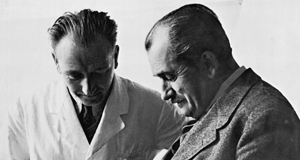 |
Prof. Ferdinand Porsche confers with engine designer Franz Xaver Reimspiess at the Kronenstrasse office in 1938. |
The Allies expected no surprises in the rustic village of Gmünd, in Austria's mountainous southern province of Carinthia. The year was 1945, the month May, and Germany had just capitulated. Scarcely a month had passed since Allied detachments had swarmed over the Bavarian Alps west of Salzburg. There they'd expected to overwhelm the high command of the Third Reich, which-according to the Josef Goebbels propaganda machine-was sealing itself into rock caverns and planning to wage a glorious last battle.
But the feared "National Redoubt" did not exist after all-at least not in the form imagined. Instead of a rocky high country honeycombed with tunnels and bristling with pillboxes, the Allied troops saw grazing cows and placid settlements of nonbelligerents who were only too happy to be Bavarians again. British forces commanded the mountainous southerly sector of Austria, near Bavaria and bordering on both Italy and Yugoslavia. The troops patrolling the narrow roads and quiet villages of Carinthia had no reason to think that they would find anything out of the ordinary in a village as remote as Gmünd.
About 25 miles north of the Italian border, on a gravelly delta at the confluence of the Malta and Lieser rivers, Gmünd was little more than a layby along Route 331, the twisting road that linked Klagenfurt, Carinthia's capital, with Salzburg, some 70 miles to the north. With its steep-roofed houses and split-rail fences, Gmünd looked like just another bucolic Austrian village. Several citizens, however, suggested to the British officers that they pay a visit to the sawmill that stood on the edge of town in the Malta valley. There they found, clustered around the one-story sawmill and a small outbuilding, a strange assortment of vehicles: various models of the Volkswagen, the "people's car" ordered built by Hitler.
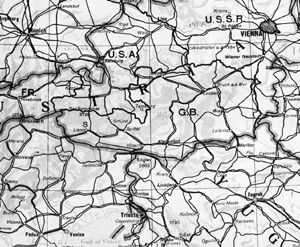 |
In the Allied occupation zones established in Austria after the war, Gmünd was in the British zone, south of Salzburg and north of Trieste. |
But this was more than a boneyard for Adolf's dream car. The collection included a rare convertible, military models and a claustrophobically streamlined coupe. Inside the wooden buildings, the British found the biggest surprise of all: the chief designer, the core of the engineering staff and much of the records and equipment of one of Germany's most respected engineering firms-the Porsche KG. This was the brilliant team that had designed the versatile military Volkswagen in both conventional and amphibian versions, not to mention such armored vehicles as the awesome Elefant anti-tank weapon and, in the last months of the war, two prototypes of the largest tank ever conceived-a machine ironically dubbed the Maus (Mouse).
No one had known the Porsche staff was there: not Britain's MI5, the American OSS or the Soviet GRU-shrewd investigators who had every reason to want to know the team's whereabouts. Since the autumn of 1944 these men-fully half of Porsche's 588-man engineering cadre-had been undisturbed at their work in the peaceful haven of Gmünd. Their removal to Carinthia from bomb-shattered Stuttgart had, as intended, allowed them to work undisturbed on new tanks, engines, personnel carriers and even farm tractors for the peacetime that had now so suddenly arrived. And their evacuation to Austria had gone undiscovered by the Allies-until now.
This half of the Porsche company was destined to spend almost six years in Gmünd, not a long time for a firm that had been founded in 1930. Yet six years were enough to conceive and rear a child to school age. In this instance they were also enough to bring a new kind of automobile out of the cradle and onto its first unsteady footing. Gmünd was the birthplace of the car we know today as the Porsche.
Porsche Beginnings
The Porsche name had been part of automobile history from as early as 1900. That year, the Lohner-Porsche was being built in Vienna to the designs of the brilliant Ferdinand Porsche, a mere 25 years of age. Then, as throughout his career, the founder of the Porsche dynasty made his living by designing for others. After Lohner came Daimler of Austria, Daimler and Daimler-Benz of Germany, followed by Steyr, Auto Union and Volkswagen, to name only the most prominent firms that engaged his services.
Until 1929, the year he spent with Steyr, Porsche had been directly employed by the companies he served. But this arrangement had not always been fully satisfactory. Says Ferry Porsche, his son and successor: "My father found that when he signed a contract with a firm, they could live another ten years on his designs, but he couldn't!" Porsche therefore decided to set up his own design office. As he told his son: "It makes no sense for me to keep going to one company after another."
Obtaining financial backing from investor friends, Porsche established his firm in 1930. Some work for the new company was being done in Austria in August of that year; a few months later, on December 1, 1930, its headquarters were opened in Stuttgart, Germany. Nestled in a natural amphitheater along the Neckar River (a tributary of the Rhine), Stuttgart was the home of numerous automotive and engineering firms. These would serve as a major source of supply and talent for the new Porsche enterprise.
 |
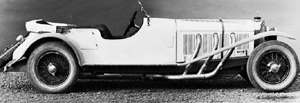 |
Ferdinand Porsche developed the supercharged 1924 Mercedes (top) and 1927 Mercedes-Benz Type S. |
On March 6, 1931, the Porsche corporation was officially registered with the German authorities. Its first project, the design of a Wanderer automobile, was designated Type 7. At the end of its first year, the new company had just 19 employees. By 1938 its payroll had soared to 176, of whom 72 were engineers and administrators. By that time, the prosperity of the Porsche enterprise-booming to meet the demands of the Volkswagen project-was such that the company was able to build offices of its own in the Stuttgart suburb of Zuffenhausen. The new headquarters offered complete facilities for designing, building, and testing motor vehicles. Moving overnight to avoid the loss of a single working day, the Porsche men were installed in Zuffenhausen in June 1938. Here, in the same year, they completed the design of the car that would become known as the Volkswagen-the car that was to make Porsche's name world-famous.
Meanwhile, the company's success enabled Porsche to be restructured as a limited partnership, called in German a Kommanditgesellschaft or KG. The change, which occurred in 1938, marked the rise to full ownership of the firm by members of the Porsche family, including a new generation that had begun to take an active role in the company's affairs. Among those sharing leadership in the Porsche enterprise were the children of Porsche's marriage to Aloisia Kaes: his son Ferry and his daughter Louise, along with Louise's husband, Dr. Anton Piëch.
Louise, the first-born (1904), was an exceptional, determined woman whom many saw as the purest embodiment of her father's spirit. Anton Piëch, whom she married in 1927, was from a Viennese family of French origin. Having followed in his father's footsteps by training as a lawyer, the energetic Piëch was a founding partner of the Porsche design office and a vital negotiator of its major contracts. During World War II, he served as Ferdinand Porsche's deputy at the Volkswagen factory near Fallersleben, west of Berlin.
Porsche's son, Ferdinand Anton Ernst Porsche, was born in 1909. Nicknamed Ferry, he was immersed in automotive lore from his earliest days. "I have, so to speak, come into the world with the automobile," he once said. At ten he was able to drive, and at 16 he was behind the wheel of an experimental Mercedes. Trained and apprenticed in every important discipline of the industry, Ferry Porsche became an employee of the Stuttgart office in 1931. There he completed his first drawing-that of a Wanderer connecting rod. With a Wanderer, a car he had test-driven as well as helped design,
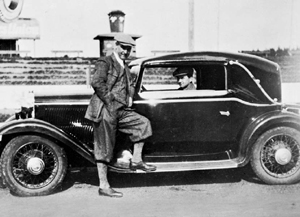 |
Ferry Porsche, at the wheel, helped design and test the 1932 Wanderer. |
Ferry competed in the Baden-Baden trial in 1934: a 2,000-kilometer run over the open roads of Germany. In 1939 he took over the management of the Zuffenhausen office after his father was made one of the directors of the new Volkswagen factory.
Adolf Hitler laid the cornerstone of the new Volkswagen plant on May 26, 1938. Frustrated by the refusal of the existing German auto companies to cooperate with him and with Porsche in building a "peoples car," Hitler decided that the nation would build it instead. The money was to come from the German Labor Front, a pseudo-union organization headed by Dr. Robert Ley. One of its branches, known as Kraft durch Freude (Strength through Joy) or KdF, was to handle the sales of the VW, which was henceforth to be known as the KdF-Wagen. Another branch, set up in May 1937, was the Corporation for the Advancement of the German Volkswagen, which was responsible for getting the new car on the road.
The People of Porsche
The principals of the VW-building company were Dr. Bodo Lafferentz, a Ley deputy; Ferdinand Porsche and Jakob Werlin, the Munich Mercedes-Benz dealer and representative who advised Hitler on automotive matters. Although the company officially had a Berlin address, from mid-1938 on it was actually based in the new Porsche Zuffenhausen works. These were the simplest aspects of the incredibly complex organization that the Third Reich created to build the VW. A curious entity, it at once included Ferdinand Porsche and was also a customer for his firm's designs. Needless to say, this was an invitation to Porsche and his team to expand their operation, its turnover and its profits.
As was his custom, Porsche proposed many more versions of the VW-to-be than just the simple sedan. In its final form, the basic chassis was known as the Type 60 (marking its place in the succession of Porsche projects since the Type 7). Designed for the Type 60 chassis were sedan, convertible sedan, and cabriolet bodies-essentially those the world later came to know well.
Other variations on the VW theme were worked out by the exceptionally talented
Austrian-born Porsche staff. At its head, as chief designer, was Karl Rabe (born in 1895), who for so many years was Porsche's link between inspiration and realization. The modest and bespectacled Rabe had been one of the first men Porsche called upon when he opened his own office. Despite his self-effacing manner, Rabe was no stranger to responsibility and would show his best in the worst of times.
Like Rabe, Franz Xavier Reimspiess (born in 1901) was known to Ferdinand Porsche from his days at Austro-Daimler before World War I. His contribution to the VW and thus, indirectly, to the Porsche car was the fundamental conception of the air-cooled four-cylinder opposed engine used in the Type 60. At Steyr, Porsche had come to know two more close associates. One was Karl Fröhlich (born in 1898), who was a gearbox specialist. The other was Josef Kales (born in 1901), an aero-engine designer. Kales devoted most of his time to the problems of the Volkswagen and remained with that firm after the war. Joseph Zahradnick (born in 1900) was also among those whom Porsche and Rabe first hired to help them in Stuttgart in 1931. He was responsible for steering and front-suspension designs.
In those pre-computer days, the staff relied on one man for its theoretical computations: Josef Mickl. Born in 1885, Mickl was the oldest member of the team apart from Ferdinand Porsche himself. He first worked for Porsche in 1917 and was at his desk in the Kronenstrasse office as soon as its doors opened in December 1930. When calculations of vibration frequencies, performance characteristics or structural stresses were needed, Mickl made them. With a background as an aircraft designer in Austria and Yugoslavia, he took a special interest in the aerodynamic problems of automobiles. Mickl was the key man behind the design of a Land Speed Record contender prepared by Porsche in 1937 and built by Daimler-Benz.
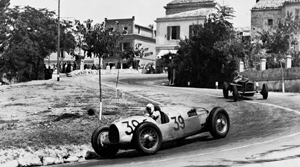 |
The successes of the rear-engined Auto Union (here in the 1935 Coppa Acerbo) brought worldwide fame to the still-new Porsche design organization. |
Also concerned with body design, but in a quite different way, was Erwin Franz Komenda. He came to Porsche in November 1931 from Daimler-Benz, where he'd been deputy director of production-car body design at the respected Sindelfingen plant. Born in 1904, Komenda had learned his trade in Steyr and then in Vienna with a firm that made heavy coaches. He was drawn into the budding automobile business, where his capacity for infinite detail was appreciated. Intense and positive in all his views, even to the extent of defying his boss's instructions (something few at Porsche dreamed of doing), Komenda was at heart a kind and deeply thoughtful man. He, Mickl, Reimspiess and Rabe remained stalwarts of the Porsche organization through the early 1960s.
Knit tightly into a team by their mutual respect, common nationality and veneration of Porsche, these were the men who, in the late 1930s, were eager to enrich the motoring world with variations on the basic Volkswagen theme. The factory then being built at Fallersleben was intended to produce 150,000 cars in its first year and to build up eventually to ten times that volume. Clearly more than a sedan and convertible would be needed to assure continuing demand sufficient to support that kind of volume.
Other VW versions were quickly planned. Type 66 was a right-hand-drive model, Type 67 was an invalid vehicle1, and Type 68 was a small panel van. The Type 62 was an open-sided cross-country variant with high ground clearance. Eventually it provided the foundation for the military Type 82 Kübelwagen that was to become justly famous during World War II. As wartime needs intensified, it was followed by the four-wheel-drive Type 87 and the famed and versatile Schwimmwagen, the amphibian Type 166.
Seeds of a Sports Car: Types 64 and 114
Thoughts of Wehrmacht-green Volkswagens going to war were still far away in 1937 when the Porsche designers sketched the specifications of another member of the VW family, the Type 64. This was to be a sports car, the kind of sporting variation that Ferdinand Porsche liked to engineer for each of his new car designs. This was partly to satisfy his own enthusiasm for fast cars and partly as a means of pushing each concept nearer its limits. Instead of the standard car's 1.0-liter engine, for example, the paper study for the Type 64 proposed an enlargement to 1.5 liters. Other design changes made the Type 64 a distinctly different kind of VW, with an aluminum body and a top-speed potential of 90 to 95 mph.
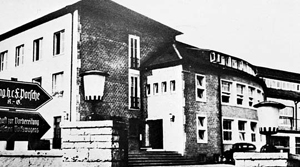 |
Zuffenhausen became Porsche's home in June 1938. The move to these new quarters also supported the planning effort for the. |
"What are our prospects for building this car? May we have a budget to build some prototypes?" Porsche representatives posed such questions to Ley and Lafferentz during meetings in late 1937 and early 1938. The replies were not encouraging. Building and selling a production sports car did not suit the immediate plans of the German Labor Front, which wanted to project a responsible image. In 1938, after all, the German people had just begun paying their hard-won savings into a giant layaway plan to buy KdF-Wagens.
In spite of this rejection, Porsche's people believed enough in the potential of a car like the Type 64 to try a new approach to getting it into production. They decided to explore the possibility of building it themselves. This would mark a full turn of the wheel for the Porsche family, from working for other car makers to becoming an auto producer in their own right. Looking beyond the design work Porsche was then doing on the VW project, which seemed certain to be one of the biggest the firm could ever hope to get, the idea of actually producing a car offered financial security for the future. Porsche could start out in a small way, in its own new works in Zuffenhausen, expanding later in response to demand.
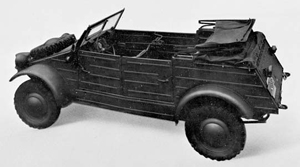 |
The Type 82 Kübelwagen produced by Volkswagen during World War II. |
It had occurred to Ferdinand Porsche as early as 1922 that he might go into the automobile business on his own. This was, said Ferry Porsche in an interview with Panorama, "an old idea of my father's. When he left Austro-Daimler to go to Mercedes, he had the idea to do something a little like what Bugatti had done, and it was a question of having enough money to start a factory or to go to Mercedes as technical manager. At that time he didn't have enough money, so he went to Mercedes." Now, when Professor Porsche was beginning to have money, he felt the urge again.
Because the Type 64 used many components from the Type 60, the Porsche company approached Labor Front officials to make arrangements for buying Type 60 parts in quantity for use in its sports car. This request was also turned down, but for a different reason. Probes of the relevant laws by both parties had concluded that there was no legal way a government-owned company, namely the VW factory, could sell goods to a private firm like Porsche. That decision ended for the time being any and all thoughts of a Porsche sports car based on VW parts.
 |
On the eve of war in 1938, Porsche showed Hitler the VW. |
But the Porsches father and son had given so much consideration to producing a sports car of their own that they could not shake off the idea. In 1938 they decided to pursue it further in spite of all the obstacles they had encountered. Since VW components weren't to be made available, they put a small group of designers to work on a completely special sports car that was called the F-Wagen, for both Ferry and Ferdinand, carrying the designation of Type 114. The engineer most responsible for its creation was Karl Fröhlich. He kept design work moving ahead as quickly as he could, although as a nonpaying project the Type 114 drawings often had to be pushed aside to complete a job for a Porsche customer.
The Type 114 was never built; indeed, the detailed engineering drawings that would have been needed to build it were never completed. But by January 3, 1939, when Karl Fröhlich signed the drawing of its overall chassis layout, it was completely planned in every important detail: a magnificent Porsche sports car primed and ready to launch the family's own automobile business.
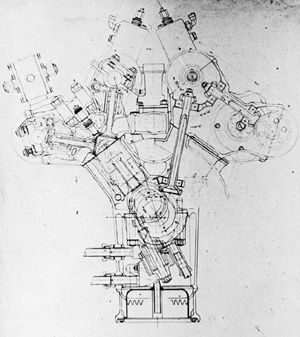 |
The V-10 1.5-liter engine designed for the Porsche Type 114 had shaft drive to its four overhead camshafts, three downdraft carburetors and a water pump driven directly by the crankshaft nose. |
The F-Wagen was an extraordinary conception. Not for another quarter-century would Porsche build a car of its own of comparable complexity. In its broadest outline, the layout of the F-Wagen showed a familial resemblance to the Porsche design that had been known at first as the P-Wagen, the famous Auto Union Grand Prix car. Its engine was located between the passengers and the rear axle, and its transmission was overhung to the rear of the axle. These elements alone made the Type 114 a radical automobile for its time. But its most surprising attribute was surely its ten-cylinder vee-type engine of 1.5 liters (1,493 cc, 58 x 56.5 mm).
The choice of ten cylinders was radical for the time, but not unique. In the late 1930s, engines of both five and ten cylinders were being advocated in technical circles and were being experimented with by Ford. Lancia even put a five-cylinder into production. Designers saw the V-10 as a useful and logical compromise, shorter than the V-12 yet offering more power, through higher speeds, than a V-8 of the same displacement. The Porsche team chose the V-10 configuration to power two vehicles it was working on in 1938: its Type 100 tank prototype2 for the German Army, which required two 15.0-liter air-cooled V-10s, and the Type 114 sports car.
With a 72-degree angle between its banks-the correct value to give evenly spaced firing impulses-the engine designed for the Type 114 would have been the most ambitious 1.5-liter engine of its time, as sublimely intricate as a Swiss watch. In both this angle and its use of ten cylinders, the Type 114 engine accurately foreshadowed the Formula 1 racing engines of the end of the twentieth century. Porsche's ten were to have aluminum heads. Wet cylinder liners in an aluminum block were to extend down well past the crank centerline to a split line that sloped down toward the rear, between the block and sump, as had that of the Auto Union V-16.
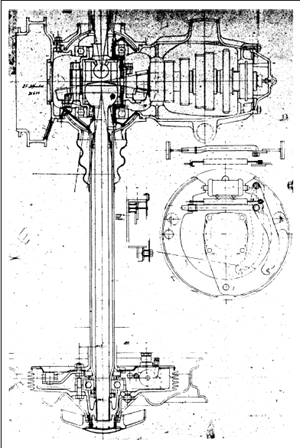 |
The five-speed transaxle designed for the Type 114 drove through a ZF limited-slip differential. engine. Porsche's planned production car, the Type 114, had its V-10 engine placed above the rear torsion-bar tube. |
In the design, all the crankshaft bearings were low-friction rollers, and the six main bearings had removable caps and split outer races. The rod journals were to be assembled in such a way that the connecting rods could have strong one-piece big ends-a method developed by Hirth, the Stuttgart specialists. Domed pistons poked their crowns into deep hemispherical combustion chambers containing two valves symmetrically inclined at an included angle of 88 degrees. Twin coil springs and pivoted fingers comprised the valve gear, and the twin overhead camshafts on each bank were driven by shafts and bevel gears at the rear end of the engine. Each inlet camshaft was turned by a shaft from the crank, and a short relay shaft from the inlet bevel drove each exhaust camshaft.
A magneto for each bank of the Type 114 engine was to be driven from the back of each inlet camshaft. Three single-throat downdraft carburetors were to be squeezed between the banks on a log manifold; at the planning stage no supercharger was contemplated. Through a single-disc clutch, the V-10 was to drive a transaxle with a five-speed gearbox. Its top four ratios were to be constant-mesh with engagement by dog clutches. A takeoff pulley from the rear of its input shaft was to drive a belt to a rear-mounted generator.
Fröhlich's design for the F-Wagen's suspension followed the classic Porsche pattern of the period, much like that of the Volkswagen. It called for the rear wheels to be mounted on swing axles, guided by flexible trailing arms from a torsion bar held in a transverse tube. Front wheels were to be sprung by parallel trailing arms and transverse torsion bars. These systems were to be connected by a ladder-type tubular frame with oval-section longerons, five inches deep, kicked up at the rear over the swing axles. The plans specified finned drum brakes 11 3/4 inches (300 mm) in diameter, set inside 17-inch disc wheels with pin-drive knock-off hubs. Rims 3 1/4 inches wide were to carry 5.50x17 tires, with the spare mounted in the nose.
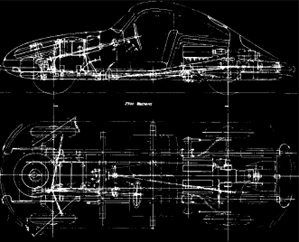 |
The Type 114 was to have an oval-tube ladder frame, kicked up over its rear swing axles. Front-radiator layout is at left. |
Styled by Erwin Komenda to suit the two-passenger mid-engined chassis, the Type 114 body resembled a stretched Volkswagen. A scale model made for wind-tunnel testing showed a pointed tail; a low, flat nose; and flush, pontoon fenders with enclosed rear wheels. Differing from the VW was the grille in its nose for the coolant radiator, which in the initial design was mounted ahead of the 14.8-gallon fuel tank. This layout had been changed by January 1939, when the radiator was moved to the rear, just ahead of the engine, where it was cooled by a turbine-bladed suction fan. This required the wheelbase to be stretched from 106.3 to 108.3 inches, while the track stayed the same at 53.2 inches.
These were the essentials of the Type 114, an ingenious sports car like none other in the world, the car the Porsches hoped to produce themselves as soon as the growing tensions in Europe had subsided-perhaps after a year or so. In the meantime they were recompensed for part of the design work when the engine and transaxle plans of the 114 were used in planning a 1.5-liter racing car (designated Type 116) which was contracted and paid for by the Volkswagen works. VW never built and raced this car, but it came close to doing so in 1939 with a simpler sports car-one looking much like the Type 114 that came from the same drawing boards in Zuffenhausen.
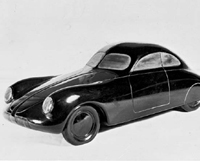 |
Wind-tunnel test model, showing grille for front radiator. |
Plans for new racing and sports cars were still being made as late as 1939 in Germany, for there had been no signals, either to or from those in charge of auto racing, that their favorite pastime would be suspended by a major war. Motor sport in the Third Reich was under the centralized control of the National Socialist Motoring Corps, the NSKK, and its Korpsführer, Major Hühnlein. A long-time Hitler crony, the gruff and blustering Hühnlein had total jurisdiction over all sporting uses of cars in Germany. Part of this control was exercised through the Oberste Nationale Sportbehörde or ONS, the Highest National Sporting Authority. This was the body which was internationally recognized to sanction races and record runs in Germany, which it did with traditional Nazi meticulousness, pomp and panoply.
Local events, chiefly in the formats of rallies and trials, were organized by NSKK paramilitary groups and brigades during the 1930s, while big national competitions were staged under ONS direction. These included a winter trial in February, a three-day mountain trial in June and late in the decade, a German Alpine Rally in July. Not since 1934, however, when they had staged the 2,000-kilometer event in which Ferry Porsche had driven a Wanderer, had the NSKK and ONS organized a big open-road race on the lines of the Mille Miglia. In 1938 they decided to get back in that business in an even more spectacular way.
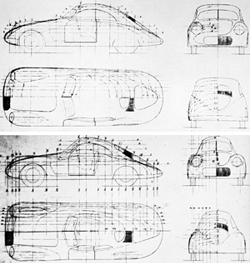 |
Top: In September 1938 two different body layouts were prepared for the Type 114 in its original front-radiator form. One was a wide sportstouring body, with seating space for three.
Bottom: The wider coupe's designation was Type 114K1. This narrower two-seater coupe design for the mid-engined Porsche-to-be, planned for competition, was identified as the Type 114K2. |
Berlin to Rome: Type 60K10
In cooperation with his counterparts in Italy, Korpsführer Hühnlein planned one of the most audacious races ever conceived. They scheduled it for September 1939. The starting point was to be Berlin, the cars racing south from there over the newly completed Autobahn to Munich. They'd continue south through the Austrian panhandle over the Brenner Pass to Italy, then race over local roads, closed to other traffic, all the way to the finish line in Rome. This Berlin-Rome Race was to traverse three nations from capital to capital over 800 highway miles, an epic event with unlimited propaganda potential.
For the Porsche and KdF-Wagen staff in Zuffenhausen, this race promised a publicity bonanza. Although construction of the Fallersleben plant was lagging, the first manufacture of Volkswagen cars was still projected for September 1939 and the first deliveries for early 1940. The Berlin-Rome Race was a made-to-order opportunity to demonstrate to the world the guts and character of this new German automobile. Of course the stock KdF-Wagen would be out of its element, with only 24 hp from 985 cc and a top speed of about 65 mph. Still, argued Ferdinand Porsche, special cars could be built on the Type 60 chassis that would perform extremely well.
Thus persuaded, Hühnlein's ONS placed an order with Porsche for the design and construction of three special sports cars based on the Type 60. Financial backing came from the Labor Front of Ley and Lafferentz.3 Although they had just turned down Porsche's plans for putting the Type 64 sports car into production, they too saw the publicity advantages to be gleaned by entering a KdF-Wagen in the Berlin-Rome competition.
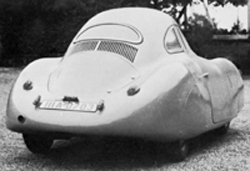 |
Erwin Komenda was successful in retaining a visual resemblance to the normal Volkswagen in the Type 60K10, built in 1939 to the order of the German Labor Front. |
Designed in the fall of 1938 and completed in the early summer of 1939, three cars were built specially for that contest and were designated Type 60K10, indicating that each consisted of a Type 60 chassis fitted with a special body (K for Karosserie). The K series, which included early studies for the Volkswagen body design and some other styles besides the Type 60K10, ran up to the K12 level.
Planning already done at Porsche on the Type 64 sports car gave it a head start on engineering work on the 60K10. Retained intact was the normal Volkswagen platform frame and its suspension system. Thus wheelbase and track remained standard at 94.5 and 50.6 inches respectively. Larger valves, twin carburetors and a higher compression ratio boosted engine power to over 50 bhp, more than twice its normal output. It was also developed to be reliable at peak output, so the car could take full advantage of the high speeds that were possible between Berlin and Munich on the Autobahn leg of the race.
That fast stretch of road was also to be exploited fully by the special aluminum coupe body built for the car by Reutter of Stuttgart. Its design, by Komenda, resembled that of the Type 114 being planned in parallel, but it was even more extreme, with pants enclosing all four wheels and a minuscule coupe cabin. As did the 114, it also kept the window pattern, rear-deck louvers and front-deck surface embellishment of a normal Volkswagen-aesthetic touches which were essential if the three racers were to have any value in promoting sales of the standard KdF-Wagen.
The coupe's roof lines were so narrow that it looked like a single-seater, but the car actually managed to accommodate two people by having the passenger seat staggered about a foot to the rear of the driver's seat. A large fuel tank was set into the space thus cleared on the right side of the car's nose. The battery was stowed behind the driver. There was room under the long nose for two spare wheels and tires, which sat on a common plane. The completed car weighted less than 1,200 pounds.
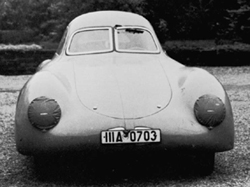 |
Three Type 60K10 coupes were made. With blackout masks on the headlights, as shown, they served as high-speed transport during the war for Ferdinand Porsche and others. |
Capable of reaching and maintaining a timed maximum speed of 90 mph, the 60K10 was tailored perfectly to the special needs of the Berlin-Rome event. Three cars were ready, but the race was not. By September 1939, it was obvious that a major war was under way and that such a race could not be held, even on the home territory of the Axis powers. Instead of being used as racers, the three coupes became valuable and distinctive personal transportation. One was used by Bodo Lafferentz until he bent it in a collision with another car. Although its damage seemed repairable, this coupe appears not to have survived the war.
The two other coupes remained in the hands of the Porsches. One was used occasionally by Jakob Werlin, and the other was driven by Ferdinand Porsche and Josef Goldinger, his chauffeur. At least one of these was given better visibility for road use by fitting the windshield and side windows with slimmer frames and larger panes of glass. At the same time, the wiper pivots were moved from above to below the windshield. These deep-skirted coupes had flip-out trafficators in their fender sides and twin Bosch horns built into the nose.
Because it was often the fastest means of getting around, Professor Porsche made frequent use of his Type 60K10. Along the Autobahns that radiated out of Stuttgartt it scuttled at high speeds, narrow beams of light from its blackout-masked headlights penetrating the foggy Swabian gloom. There wasn't much traffic on German roads during the early 1940s, so excellent averages could be maintained. Porsche and Goldinger once arrived at the Hotel Bristol in the center of Berlin just one-and-a-half hours after leaving Fallersleben. That amounted to a door-to-door average speed of about 85 mph achieved over ordinary local roads!
Honors and Armaments
Ferdinand Porsche was kept very much on the move by both the honors and the responsibilities that came his way in increasing numbers. He had already received two honorary engineering doctorates from technical academies, the first in Vienna in 1917 and the second in Stuttgart in 1924. He was awarded a German National Prize in 1938, was named the official Reich Auto Designer, and in 1940 he was presented with an honorary professorship by the Stuttgart Technical Academy.
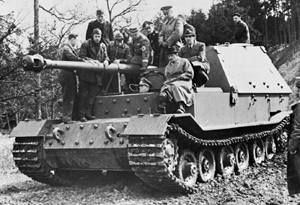 |
The "Ferdinand" with Ferdinand Porsche on its left front corner and Albert Speer at the controls. |
Of more than academic interest was Professor Porsche's 1940 appointment to the presidency of the Armor Commission of the Ministry of Arms and Munitions. During the next five years, his time was spent amid the mud of military proving grounds and the tattoo of rivet guns in huge tank assembly halls rather than on the racing circuits he loved so much. Porsche plunged his organization into the design of armored military vehicles with the same enthusiasm that had already made his firm famous in other fields.
This wasn't a new discipline for Porsche, for he had worked on weaponry, including an amazingly advanced eight-wheeled personnel carrier, at Daimler-Benz in the 1920s. In 1941 the Porsche office followed up its Type 100 tank prototypes with its 57-ton Type 101, also known as the Tiger (P).4 Type 103 was a variation, with hydraulic drive instead of the electric drive that Porsche preferred. Powering these tanks were two V-10 air-cooled gasoline engines. Fitted with Solex carburetors and magneto ignition, these had pushrod-operated overhead valves and developed up to 320 bhp at 2,500 rpm, albeit not reliably enough to qualify them for battlefield use. Five had been completed when production was halted; Henschel's version, the Tiger (H), was commissioned instead.
Hopes had been so high for the Tiger (P) that production of its hulls had been forging ahead. These and some additional chassis, powered by Maybach V-12 engines, were used instead as the basis for 90 Elefant anti-tank vehicles produced in April and May of 1943.5 Another series of tank designs, the Type 180 and 181, was outlined on paper, but only a turret was built, early in 1942. Porsche-designed turrets contributed to the success of the 68-ton Henschel-built Tiger II tank. In June of that year, Porsche prepared its first drawings for the Type 205 or Maus, a 180-ton colossus envisioned by Adolf Hitler as a movable bunker, a battleship for war on land. Powering it was an enlarged version of the Type 212, an X-pattern 16-cylinder air-cooled diesel conceived for use in smaller tanks.
 |
The seeds of these armored giants sprouted from the fertile soil of Austria, which had nourished so much of Porsche's creativity. Links with the Professor's old associates at Austro-Daimler and Steyr were exceptionally close. The Type 212 engine was built in Vienna at the engine- and vehicle-producing firm of Graz-Simmering-Pauker, while Porsche's tanks and prototypes were fabricated at the Nibelung Works at St. Valentin, just north of Steyr, a plant which was operated by Steyr-Daimler-Puch. Installed there as chief designer was Porsche's Franz Xaver Reimspiess.
Porsche's attention was frequently needed at St. Valentin. It was also demanded at the VW plant at Fallersleben, where his son-in-law was his deputy, and at Peugeot's factories in France, which had been placed under the authority of the KdF plant during the German occupation. Of course Porsche's presence was also required in Berlin and expected at least two days a week in Zuffenhausen, at the main design office which was then under Ferry Porsche's direction. There the family was drawn to the Ferdinand Porsche villa, with its steeply-gabled tile roof, number 48 on the Feuerbacher Weg, high on a hill overlooking Stuttgart. Relaxation was snatched whenever possible at the family's Austrian farming estate at Zell am See, south of Salzburg. To the southeast, near Klagenfurt in Carinthia, the ten-mile-long Wörth Lake had been a favorite summer holiday spot for the Porsches since the early years of the century.
These were but some of the destinations on the crowded wartime itinerary of Ferdinand Porsche. Porsche people traveled so much that berths on sleeper trains were booked for them on a daily basis. After sharp differences with Albert Speer, the Reich armaments minister, Porsche was moved out of his Armor Commission job to a more elevated and mainly ornamental post, that of Reich armaments councilor. His continued advocacy of exotic drives, engines and suspensions for tanks at a time when Germany needed mass production rather than the ultimate in sophistication had earned Porsche a "mad scientist" reputation in some circles.
Ideas for advanced armor kept rolling out of the design office at Zuffenhausen and the plant at St. Valentin. The mountainous Maus was shown to work amazingly well in one of the two completed examples. Drawings and models were prepared of a relative dwarf, the 18-ton multipurpose Type 245. A similar stage was reached with the design of the Type 250, a turretless tank with a 105 mm gun. One of Porsche's last military projects was the Type 293, laid down in the summer of 1944 by order of the SS. A personnel carrier rolling on either wheels or tracks, it had to be developed with parts made in Italy because Stuttgart was under increasingly heavy bombardment.
 |
Versatility as well as volume marked the wartime Porsche contribution. It produced many variations on the Volkswagen theme. Almost as ambitious was another Reich-supported Porsche endeavor, the Volkspflug or "people's plow," designed to motorize the German farmer. This was a small yet versatile tractor designed to do all the tugging and tilling that oxen normally performed on small farms in Germany. Conceived late in 1937, the first Volkspflug design was the Type 110, followed by successive type numbers through 113 as development continued into 1940. Plans were made for a vast factory at Waldbröl, near Cologne, to make as many as 300,000 tractors a year. In 1944 this dream was allowed to die along with so many other aspirations of the Third Reich.
Nor was this all the work being done by the Porsche staff. It designed the Type 175 Ostradschlepper ("wheeled Eastern-Front tractor") of 1942, a heavy truck with huge steel-tracked wheels. A throwback to some of Porsche's World War I creations, it was built to tow artillery pieces through the gumbo of the Russian front, but military conditions changed before the Skoda-built vehicle could be properly tested. Porsche also built a VW engine fitted with a special Roots-type supercharger, which was to power portable aerial tramways in the rarefied Alpine atmosphere. One such engine, delivering 45 horsepower, propelled the bright-green Volkswagen cabriolet that Ferry Porsche used throughout the war.
Then there was the Porsche-designed Volkswindkraftwerk or "people's wind power plant." Inspired by the irrepressible Bodo Lafferentz as another product for the huge works at Fallersleben, this new electricity-generating plant was a modern three-bladed version of the windmill. Designated Types 135, 136 and 137 (signifying three levels of generating power), such units, when mounted on high towers, were to power the farm settlements that were to be established in Germany's newly-won Lebensraum in Russia-"living space" which, of course, never became permanently available.
Preserving the Legacy Through 1943 and the early months of 1944, when Allied bombers roamed more and more freely above Germany's industrial centers, the home base of the Porsche team remained at Stuttgart-Zuffenhausen-even though many other firms had been dispersed to more sparsely settled regions. In April of 1944, however, after the first bombs fell on the KdF plant at Fallersleben, Ferdinand Porsche became highly agitated. The company's archives, he complained to his son, were stored in the attics of the office buildings, where they were very vulnerable to air attack. He insisted that they should be moved at once to the cellar, where they would be better protected.
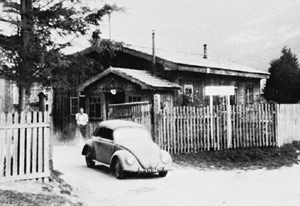 |
No external sign showed that the Porsche Gmünd office, with Ferry's cabriolet in the drive, was anything but a sawmill. |
The precaution had already been taken of triplicating the original drawings. One of the additional sets was stored in the Porsche villa and the other was at the Stuttgart residence of Ghislaine Kaes, Professor Porsche's nephew and personal secretary. They were stored in special locked containers of sheet steel. The spares were destined to come in handy. Just eight days after the archives had been moved to the Zuffenhausen cellar, an Allied bomber released a single bomb that plummeted at such an angle that it bored straight into the cellar, missing everything else but incinerating the drawings. It was finally evident that at least some of the Porsche team would have to move.
In fact the decision was no longer theirs alone. His differences with Ferdinand Porsche apart, Albert Speer made it clear that the Porsche brainpower was to be moved to less hazardous surroundings-and fast. Ferry Porsche took on the task. Applying first to the authorities in Stuttgart, he was offered a site in Czechoslovakia. He was wary of this, however. Ferry decided to bypass the Reich bureaucracy by inquiring in Salzburg about possible Austrian locations. He found one at a flying school in Zell am See. This would have been ideal because it actually adjoined the Porsche family property. But it was too small. Another site was proposed: a former sawmill in the tiny town of Gmünd, remote, lacking any rail connections, but big enough for Porsche's offices and shops.
In the end Porsche used both Austrian locales. The flying school at Zell was used chiefly for storage. Ferry Porsche divided all the important machine tools into three groups, each as much like the others as possible. One group remained in Zuffenhausen, one was taken to Gmünd and the third was stored at Zell am See. Recalls Ferry, "My idea was that we could always make a fresh start as long as we had one-third." Vehicles also went to Zell, including one of the surviving Berlin-Rome 60K10 coupes.
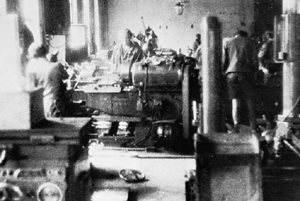 |
Inside the former sawmill at Gmünd, machine tools were installed for making farm equipment, machinery and vehicle prototypes. |
The move to Gmünd was made during the late autumn of 1944. This was a time for many decisions that were human rather than political or technical. Naturally, the Austrians who held leading positions on the Porsche staff were among those who least resisted the idea of returning to their homeland, especially (they admitted mainly to themselves) because conditions in Germany were worsening rapidly. German-born employees tended to remain in Stuttgart.
Many of those who did go to Gmünd returned home in the last months of the war to be nearer their relatives. Moreover, as Germany succumbed, the atmosphere in Austria grew increasingly inhospitable for German nationals. Meanwhile, to provide homes for many of the Gmünd emigrants, ten two-family houses were put up on a gravelly area near the river junction that gave Gmünd its name. They were of a standardized modular design that the Germans were using widely at that time.
Acting now with his father's full authority, 35-year-old Ferry Porsche took command of operations at Gmünd. Karl Rabe reported to him as technical director and Hans Kern as financial director. Kern had joined Porsche in 1933 at the invitation of Hans Baron Veyder-Malberg, who was then sales manager and a part-owner of the firm. By 1942, Kern had become fully responsible for the financial affairs of the Porsche KG. Holding the fort in Zuffenhausen was Karl Fröhlich, who maintained a liaison with the team in Gmünd. Incredibly, work on such projects as the second prototype of the mammoth Maus continued-in utter defiance of reality-into early April.
Perils of Peace
With Hitler's Reich reeling under the attacks of the Allies and doomed to imminent collapse, the Porsche clan gathered at the Zell am See estate. The elder Porsche and his wife were there, as were his son and daughter and their families. They were awaiting the arrival of the occupying authorities. British officers and troops arrived in May. Their technical representatives questioned the Professor, in a preliminary way, at Zell.
The Porsches' world changed sharply in mid-1945, as it had for everyone in Europe. "We had some money," recalled Ferry, "but it was blocked from us because we were `German.'" New barriers were thrown across the Austrian and German landscapes by the occupation authorities. Zell am See was in the American-ruled zone of Austria and cordoned off from Gmünd, which was in the British zone. There Karl Rabe had been placed in charge of the sawmill engineers by the British. In Zuffenhausen, the Porsche offices were commandeered by the Americans, whose occupation zone included Stuttgart. Karl Kirn, a man born in that part of Germany in 1909, was designated trustee of the Porsche property there.
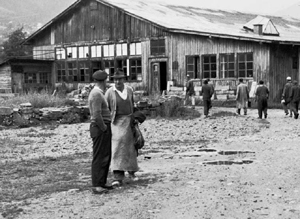 |
A large wooden hall, in a valley in the Reisseck mountains in Austria,housed the Porsche workshops. |
For these men of extraordinary engineering skills and experience the outlook was bleak. "If your father were a shoemaker," one of the British authorities told Louise Piëch, "he would surely make shoes, but he will never design automobiles again." As yet, no new plan for postwar Germany had been put forward to replace the one formulated by the Allies at their joint conference in September 1944. Known as the Morgenthau Plan, after the then-U.S. Secretary of the Treasury who had helped in its formulation, it proposed the virtual elimination of German industry and anticipated "converting Germany into a country primarily agricultural and pastoral in character."
Agriculture, at least, was a key word to the designers at Gmünd, who had never stopped thinking about tractors. With no immediate hope of seeing them built, the Porsche team worked in the autumn of 1945 on the Type 309 engine, a small two-stroke diesel suitable either for the VW or a tractor, and on the Type 312, 313, 323 and 328 tractor designs. Not until half a decade later would these ideas come to even partial fruition. In the meantime the Gmünd machine tools were used to make tractor accessories, carts, winches, lifts for transporting logs-whatever was needed. Analyst Mickl applied his erudition to the design of small, efficient water turbines, suitable as power sources for individual farms. In the workshop at Zell am See, a nephew of Professor Porsche, Herbert Kaes, once a liaison engineer between the Porsche KG and the German Army, directed the repair of those vehicles that could make their way to his door.
Meanwhile, in July 1945 Professor Porsche had been formally invited to join the many officials and technicians who were being interviewed by the Allies at a castle (code-named "Dustbin") on the outskirts of Frankfurt. Freed from Dustbin after three months, he returned to Zell. In November 1945, however, a chain of events began that was eventually to shorten the life of Ferdinand Porsche. He and his son were invited to Baden-Baden in the French zone of Germany to discuss the exciting prospect of a rebirth in France of the apparently moribund Volkswagen. While conferring there in December, Porsche was arrested by a rival French political faction. Also arrested were his son and son-in-law, who had been helping him in the negotiations.
On trumped-up charges of misconduct with respect to prisoners of war and workers at the Peugeot plant, Ferdinand Porsche and Anton Piëch were imprisoned first in Baden-Baden and then in Paris and Dijon, where conditions were deplorable. Others in his family and staff were cleared after internments of various durations. Among them was Ferry Porsche, who was released from his detainment in a Black Forest hotel in late July 1946.
During this difficult time the family's interests were looked after by one of its strongest members, Ferdinand Porsche's daughter Louise Piëch. As one of the family members put it, "She was the one out of prison." Her persistence and determination led to the establishment, with her brother, of the Porsche Konstruktionen GmbH, or Porsche Design Corporation, in Austria in 1946. Under this new umbrella the family began to plan for their future.
To Louise Piëch too came one of the slender threads they were to follow toward that future. It was a letter from a young motorcycle racer named Karl, Vienna-born but now living in Merano in Italy's South Tyrol. He had Italicized his given name to make it more mellifluous to Italian ears: Carlo Abarth.